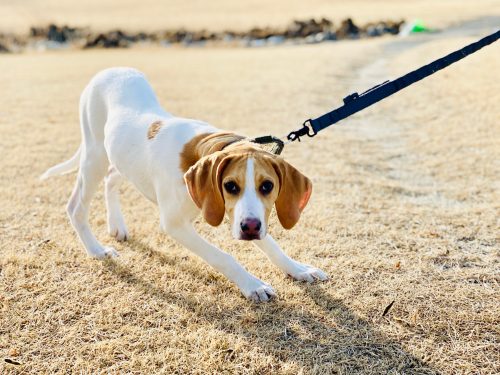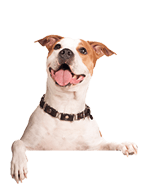You’re strolling down the street, enjoying a leisurely walk with your pup by your side. Suddenly, your dog starts pulling on the leash and barking at every passerby. Sound familiar? If you’ve ever taken your dog for a walk, chances are you’ve encountered some sort of behavioral issues. From pulling on the leash to being reluctant to walking, these problems can make walks less enjoyable for both you and your fur baby.
As experienced dog walkers in Columbus, Ohio, we’re here to share some common behavioral issues that dog parents face on walks. Additionally, we’ll provide you with our best solutions!
1. Pulling on the leash
Pulling on the leash is a common issue during dog walks that many pup parents face. Dogs naturally pull on the leash because they want to explore their surroundings. Sometimes, they also want to chase after squirrels or other animals. Needless to say, excessive pulling can lead to discomfort and pain for both the dog and the person walking the dog. In fact, it can cause injuries to the dog’s neck and trachea, and may even lead to aggressive behavior over time.
The key to solving this issue is to have the right equipment. A front-clip harness is a great option because it works by pulling the dog’s attention towards the owner. It has a D-ring attachment on the chest area, which makes it easier to control the dog’s movements. Likewise, when the dog tries to pull forward, the harness gently turns them towards the owner, making it harder for them to pull away.
Another effective tool is the head collar or Gentle Leader. This type of equipment fits around the dog’s nose and behind the ears. It gives the person walking the pup more control over the dog’s head and can be used to redirect their attention if they start to pull. The Gentle Leader works by applying gentle pressure on the nose, which mimics the natural way dogs communicate with each other. It doesn’t cause any harm or discomfort, but it does help control the dog’s movements.
Both of these options are effective because they redirect the dog’s attention and discourage pulling. They are also more humane than traditional choke or prong collars, which can cause pain and harm to the dog. If you’re not sure which option is best for your dog, you might consult with one of our professional dog walkers in Columbus, Ohio, who can assess your dog’s needs and recommend the right equipment for leash training!
2. Leash reactivity
Reactivity is a common issue among dogs, and it can be caused by various factors such as fear, anxiety, and lack of socialization. To help prevent reactive behavior during walks, it’s important to be aware of your surroundings and to keep your dog at a safe distance from triggers. This can mean crossing the street, turning around, or moving to the side to give your dog some space.
In addition, training can be very effective in teaching your dog to focus on you instead of reacting to triggers. You can use treats, special toys, or verbal praise to reward your dog for calm and appropriate behavior during walks. This helps your dog associate good behavior with positive outcomes, and it can help reduce reactivity over time. The key is being consistent with it.
If your dog’s reactivity is severe or persistent, it may be helpful to work with a professional dog trainer in Columbus, Ohio or behaviorist. They can help you identify the underlying causes of your dog’s reactivity and develop a personalized training plan to address the issue. This can include desensitization and counter-conditioning techniques to help your dog feel more comfortable and less reactive in certain situations.
Desensitization is a process of gradually exposing a dog to a trigger in a controlled environment to reduce their fear or reactivity. Counter-conditioning involves pairing the trigger with positive experiences, such as treats or toys, to change the dog’s emotional response to the trigger. Together, desensitization and counter-conditioning can be effective methods for addressing a dog’s reactive behavior on walks.
3. Excessive barking
Excessive barking during walks can be a sign of anxiety, fear, or frustration in dogs. As a dog parent, it’s important to work on desensitizing your dog to the triggers that cause them to bark excessively (as mentioned above). You can also train your dog to respond to the “quiet” command, and reward them for remaining calm and quiet during walks. Additionally, using a no-pull harness or head collar can be effective in redirecting your dog’s attention away from the triggers that cause them to bark.
Another helpful technique for reducing excessive barking is to engage your dog in activities that provide mental stimulation, such as sniffing or searching for treats. This can help redirect their focus and reduce the urge to bark. Additionally, make sure your dog is getting enough physical exercise and mental stimulation throughout the day to prevent pent-up energy that may manifest as excessive barking during walks. If you feel like you don’t always have time to walk your dog, you should definitely consider hiring a local dog walker in Columbus, Ohio to help out!
It’s also important to identify and address the underlying causes of your dog’s excessive barking. If they are barking at another dog, person, or object, try walking them in a different area, where there’s less of that stimulation.
Again, dogs may bark for a variety of reasons, such as anxiety, fear, boredom, or territorial behavior. Working with a professional dog trainer or behaviorist can help you identify the root cause of your dog’s excessive barking and develop a customized training plan to address it.
4. Scavenging (i.e. eating things off the ground)
Another common issue that many dog owners face during walks is their dogs eating things off the ground. This behavior, known as “scavenging,” can be a challenge to deal with as it puts your dog at risk of ingesting harmful substances, choking hazards, or even contracting diseases from contaminated items.
To address this issue, it’s crucial to focus on both prevention and training. First and foremost, make sure your dog is well-fed before going on walks to reduce their inclination to scavenge for food. Keep a close eye on your surroundings and steer your dog away from any potentially harmful objects or areas where garbage is present.
You definitely won’t want your dog to be on a retractable leash if they have a tendency to scavenge. Retractable leashes allow your dog a lot of leeway for roaming their surroundings. This increases their chances of getting into something they shouldn’t. Instead, you’ll want to use a flat lead and keep them close to you on walks. That way, you can see all the areas your pup comes up on, and better prevent them from getting into any scraps.
In terms of training, teaching your dog a solid “leave it” or “drop it” command is essential. Start in a controlled environment, using treats or toys, and gradually increase the difficulty by introducing distractions and practicing during walks. Reward your dog generously when they successfully ignore or let go of an item on command.
Another helpful approach is to use a basket muzzle designed to allow your dog to breathe and pant freely but restrict their ability to pick up objects from the ground. Muzzles should always be introduced gradually and associated with positive experiences to ensure your dog remains comfortable and stress-free while wearing one.
It’s important to remember that consistency, patience, and positive reinforcement are key when addressing this behavioral issue. In many cases, consulting with a professional dog trainer in Columbus, Ohio, can provide personalized guidance and support tailored to your dog’s specific needs.
5. Fear-related behaviors (ex: reluctance to walking)
Dogs can display a range of fear or anxiety-related behaviors on walks, such as excessive panting, drooling, or trying to escape from their leash or harness. These behaviors can be caused by various factors, including past traumatic experiences, lack of socialization, or certain medical conditions.
Consider using calming aids like anxiety vests or diffusers during walks. These tools release pheromones or provide gentle pressure that can help your dog feel more relaxed and secure. Positive reinforcement is also key. Provide plenty of praise, treats, and rewards when your dog exhibits calm and confident behavior during walks. This helps to reinforce positive associations with being outside and reinforces the idea that walks can be enjoyable and stress-free.
Show lots of outward excitement about the walk to your pup. As soon as you walk out of the door, begin to talk excitedly to your pup about how fun the walk is going to be! If your dog sees you excited, happy, and unafraid, you might get them to reciprocate that same attitude towards their walk-time. If you’re dog is still fearful, you might try picking them up and walking with them in your arms. Of course, this method works easiest with smaller dogs. Once you carry them far enough from home, set them down and you might notice they’re more willing to walk then!
The solution might also just involve changing the scenery. If your dog stops short during a walk, try changing directions or crossing the street. If your pup is still reluctant, try walking in a completely new area, such as a different street in your neighborhood or go to a local dog-friendly park. Sometimes the new scents can be better stimulants for them, causing them to be curious and more willing to walk!
Don’t Rule Out Medical Concerns As Cause
Above all, it’s important to consider medical concerns as a potential cause of behavioral issues on walks. Certain health conditions can cause discomfort, pain, or anxiety in dogs during physical activity, including walking, which can lead to reluctance, fear, or other unwanted behaviors.
Arthritis, for example, is a common condition in older dogs that can cause joint pain and stiffness, making it difficult for them to walk or exercise. Heart disease, respiratory problems, or musculoskeletal issues can also affect a dog’s ability to walk comfortably and cause fatigue or shortness of breath.
If your dog is experiencing persistent fatigue, coughing, limping, or other unusual symptoms during walks, it’s best to consult with your veterinarian. Your vet can perform a thorough examination and recommend any necessary tests or treatments to address any underlying medical conditions.
Addressing any underlying medical issues can help improve your dog’s overall health and mobility, and make walks a more enjoyable experience for them. It’s important to prioritize your dog’s physical health and comfort, and adjust your walking routine accordingly. A local vet in Columbus, Ohio, or a professional dog trainer, can provide guidance and support to help you develop a safe and effective walking plan for your dog.
Improve Your Columbus Dog Walking Experience Today!
In summary, addressing behavioral issues during dog walks requires patience, understanding, and proper training. By using the right equipment, establishing a routine, and seeking guidance from professionals, you can help your furry companion become a more well-behaved walking partner.
Our dog walkers in Columbus, Ohio have witnessed firsthand the positive impact of addressing these issues. So, if you’re facing behavioral challenges with your dog during walks, don’t give up! There’s always hope for enhancing your walking experience and enjoying the companionship of your furry friend to the fullest.















